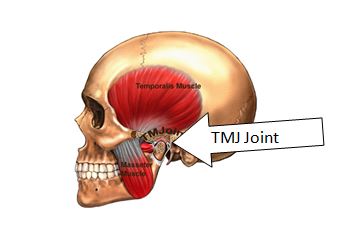What is the Temporomandibular joint?

We can locate the TMJ by putting a finger on the triangular structure in front of the ear. The finger is moved just slightly forward and pressed firmly while opening the jaw. The motion felt is from the TMJ. We can also feel the joint motion if we put a little finger against the inside front part of the ear canal. These maneuvers can cause considerable discomfort to a person who is experiencing TMJ difficulty.
What are TMJ disorders, and what are causes of TMJ disorders?
TMJ disorders are a group of complex problems of the jaw joint. This is also sometimes referred to as myofascial pain dysfunction because muscles and joints work together, a problem with either one can lead to stiffness, headaches, ear pain, bite problems (malocclusion), clicking sounds, or locked jaws. The following are behaviors or conditions that can lead to TMJ disorders.
- Teeth grinding and teeth clenching (bruxism) increase the wear on the cartilage lining of the TMJ. Those who grind or clench their teeth may be unaware of this behavior unless they are told by someone observing this pattern while sleeping or by a dental professional noticing telltale signs of wear and tear on the teeth. Many patients awaken in the morning with jaw or ear pain.
- Habitual gum chewing or fingernail biting can lead to TMJ pain.
- Dental problems and misalignment of the teeth (malocclusion). Patients may complain that it is difficult to find a comfortable bite or that the way their teeth fit together has changed. Chewing on only one side of the jaw can lead to or be a result of TMJ problems.
- Trauma to the jaws: Previous fractures in the jaw or facial bones can lead to TMJ disorders.
- Stress frequently leads to unreleased nervous energy. It is very common for people under stress to release this nervous energy by either, consciously or unconsciously grinding and clenching their teeth.
- Occupational tasks or habits such as holding the telephone between the head and shoulder may contribute to TMJ disorders.
How do we do to treat TMJ disorders?
Many TMJ related problems can often be successfully treated without surgery. Our treatment plans generally focus on calming the surrounding muscles and ligaments, relieving the pain and reducing the pressure on the joint. This can be achieved by performing chiropractic adjustments on the temporomandibular joint using a spring-loaded instrument called an Activator. We also reduce tightness in the muscles of the jaw (masseter) and neck using myofascial release muscle work.
The use of Cold Laser Therapy is also a very effective treatment we use to treat and manage temporo-mandibular joint pain. This is an FDA cleared non-thermal (non-heat producing) laser capable of penetrating deep into tissue. Laser therapy has been successfully used around the world for over 25 years, with no reported long-term or irreversible side effect. Many seek relief from TMJ jaw pain through this effective non-invasive form of therapy before resorting to surgery. We have had excellent results using the non-thermal laser to relieve pain and promote healing of this painful issue.
At times, it may be beneficial for your dentist to create a custom-fitted oral orthotic appliance. This is worn by the patient on either the upper or lower teeth and helps to relieve pressure and allows ligaments that have stretched to heal.
Stretching for Jaw Muscles and TMJ relief
Resisted Close
- Sit in a comfortable position with your head centered over your shoulders. Keep your chin neutral and parallel to the floor.
- Keep your head stable, relax your jaw and let your mouth open naturally. Put your index finger against your bottom teeth.
- Press down on your bottom teeth, gently, while trying to close your jaw. Hold for five seconds, release and repeat five times.
Resisted Open
- Sit in a comfortable position with your head centered over your shoulders. Keep your chin neutral and parallel to the floor.
- Keep your head stable, and rest your fist under your chin. If necessary, sit a table and rest your elbow on the table to keep your fist stable.
- Press up, gently, with your fist while trying to open your jaw. Hold for five seconds, release and repeat five times.
Jaw Rotations
- Sit in a comfortable position with your head centered over your shoulders. Keep your chin neutral and parallel to the floor.
- Keep your head stable, relax your jaw and let your mouth open naturally. Slide your jaw forward and back five times. Relax then slide your jaw side to side five times.
- Slide your jaw clockwise five times. Change direction and slide your jaw counter-clockwise five times.
Open Wide
- Sit in a comfortable position with your head centered over your shoulders. Keep your chin neutral and parallel to the floor.
- Keep your head stable and open your mouth as wide as comfortable and stick out your tongue as if doing a wide yawn. Hold for one second then release.
- Repeat five times and relax.